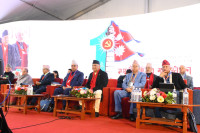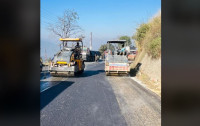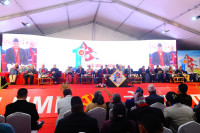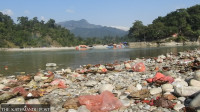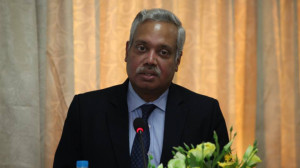National
Nepal and China sign framework for BRI cooperation in Beijing
Aid financing modalities will be adopted to fund projects under the China-led initiative.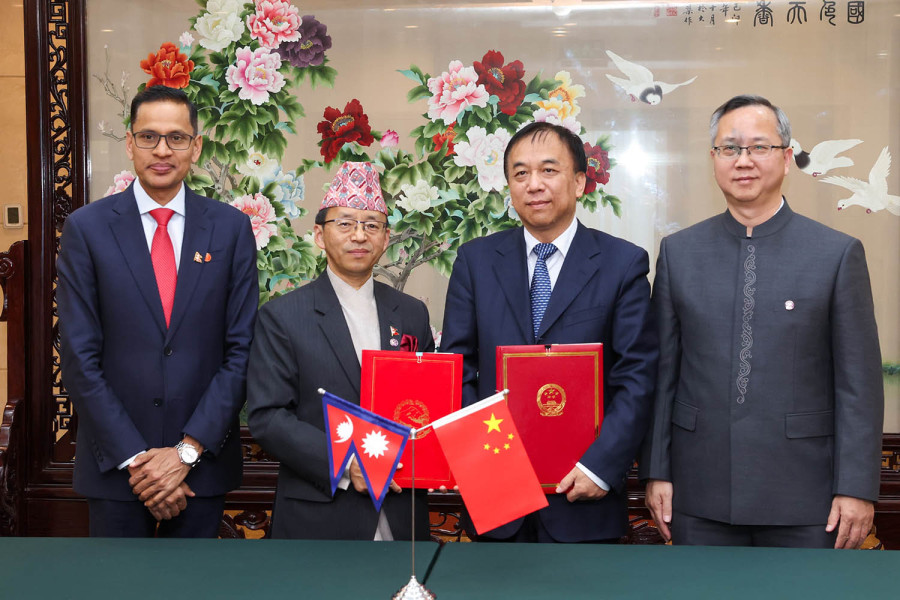
Anil Giri
Seven years and seven months after inking the Memorandum of Understanding on the Belt and Road Initiative (BRI), Nepal and China on Wednesday signed a framework for BRI cooperation during Prime Minister KP Sharma Oli’s China visit, which ends on Thursday.
Acting Foreign Secretary Amrit Bahadur Rai and deputy head of China’s National Development and Reform Commission Liu Sushe signed the framework cooperation on behalf of the respective countries. The commission is the focal agency in China, tasked with the development of BRI projects.
The framework will be valid for three years and will get another three-year extension unless terminated by either side.
Speaking briefly from Beijing with the Post, Foreign Minister Arzu Rana Deuba said that the framework signed on Wednesday is not new. “It should be understood as a continuation of the memorandum of understanding signed in 2017,” she added.
A joint task force of the Nepali Congress and the CPN-UML, the two largest parties and ruling partners, in Kathmandu had tweaked the original BRI implementation plan proposed by the Chinese side in 2020.
Wednesday’s development formally endorses Nepal’s involvement in the BRI, a programme China proposed and Nepal initially signed in 2017. But negotiations on the projects under the BRI could still prove difficult in the future.
‘Aid financing modalities’, as have been agreed under the new framework, have elements of both grant and loan, said one Nepali official who is a part of Oli’s delegation in Beijing.
“Even as we signed the framework, we were clear that we cannot accept projects under the BRI with interest rates exceeding those charged by bilateral and multilateral donors,” the official said. “Our focus would be on seeking grants and concessional loans in line with the interest rates offered by the World Bank, the Asian Development Bank and other bilateral and multilateral agencies.”
Wednesday’s agreement paves the way for negotiations on the ten projects that Nepal had proposed to China.
“Today, we signed the Framework for Belt and Road Cooperation,” Prime Minister Oli wrote in his X account. “I am honoured to reflect on the bilateral talks with Premier Li Qiang, discussions with National People’s Congress of China Chairman Zhao Leji and the highly fruitful meeting with President Xi Jinping.”
The economic cooperation between Nepal and China will further strengthen under the Belt and Road Framework Cooperation, writes Oli.
Just ahead of the prime minister’s departure for Beijing on Monday, the Nepali side had sent a new version of the framework for BRI cooperation and insisted on grants as the project financing model. But the Chinese side objected to the words and replaced them with ‘assistance financing’ and sent the document back to the Nepali side for consideration.
“Then we sat again, spoke with the prime minister and proposed a middle path using the phrase ‘aid financing’ as a modality,” one Nepali member of the delegation told the Post from Beijing over the phone. “The Chinese took some time to consider our proposal. Therefore, the new BRI framework is missing in the joint communiqué released late Tuesday. Eventually, both parties agreed on the term ‘aid assistance financing’ and the agreement was signed on Wednesday.”

On Nepal’s side, the negotiations were led by Prime Minister Oli’s economic and development adviser Yubaraj Khatiwada, Foreign Minister Arzu Rana Deuba and Acting Foreign Secretary Rai. High-ranking foreign ministry officials represented the Chinese delegation.
As Nepal and China are in different stages of development, projects will be selected on the basis of Nepal’s specific requirements and needs. During project negotiation, the final BRI framework agreement states, both sides should uphold the principle of technical, financial, commercial and economic viability and value for money. Likewise, both sides will work to create a conducive business environment.
The ‘Objective’ of the BRI framework cooperation states that both sides should facilitate the financial and technical cooperation for each project, and they identified the areas of cooperation—economic development, financial sector cooperation, transport, connectivity and logistic cooperation, trade industrial capacity and investment cooperation, and customs clearance—according to another member of the Nepali delegation who is in Beijing.
Nepal has proposed ten different projects to be executed under the BRI. They are Tokha-Chhahare tunnel road, Hilsa-Simikot road project, Kimathanka-Khandbari road and bridge, Jilong-Kerung-Kathmandu cross-border railway, Amargadhi City Hall in Dadeldhura, Jilong-Kerung-Rasuwagadhi-Chilime 220KV transmission line, Madan Bhandari University, Kathmandu Scientific Centre and Science Museum, China-Nepal friendship industrial park in Damak and Jhapa sports and athletic complex.
Nepal will set priorities and prepare the implementation plan for each of these projects. The Nepali side, in the negotiation phase, had changed several proposals.
The Nepali side significantly shortened the list of priority areas originally proposed by the Chinese side in early 2020 which included construction of the Trans-Himalayan Multi Dimensional Connectivity Network, including ports, roads, bridges, tunnels, highways, railways, aviation infrastructure, telecom projects, electricity transmission line, carrying out the China-Nepal cross-border railway project.
Similarly, the two sides will develop implementation plans for energy related projects, cooperation in the field of e-commerce and trade and industrial capacity enhancement, building trade infrastructures, adopting trade and investment liberalisation, and expanding bilateral economic relationship.
The BRI framework provides significant impetus for a stronger economic and project development partnership between the two countries, said Semanta Dahal, who was part of the task force that revised the BRI framework on behalf of the ruling coalition in a capacity of legal adviser. He added that it addresses ambiguities surrounding the infrastructure projects to be implemented under the BRI in Nepal and establishes clear negotiation principles, including the use of aid financing.
“This will facilitate negotiations on a project-by-project basis and ensure that infrastructure and connectivity projects offer value for money,” he said.




 20.12°C Kathmandu
20.12°C Kathmandu
